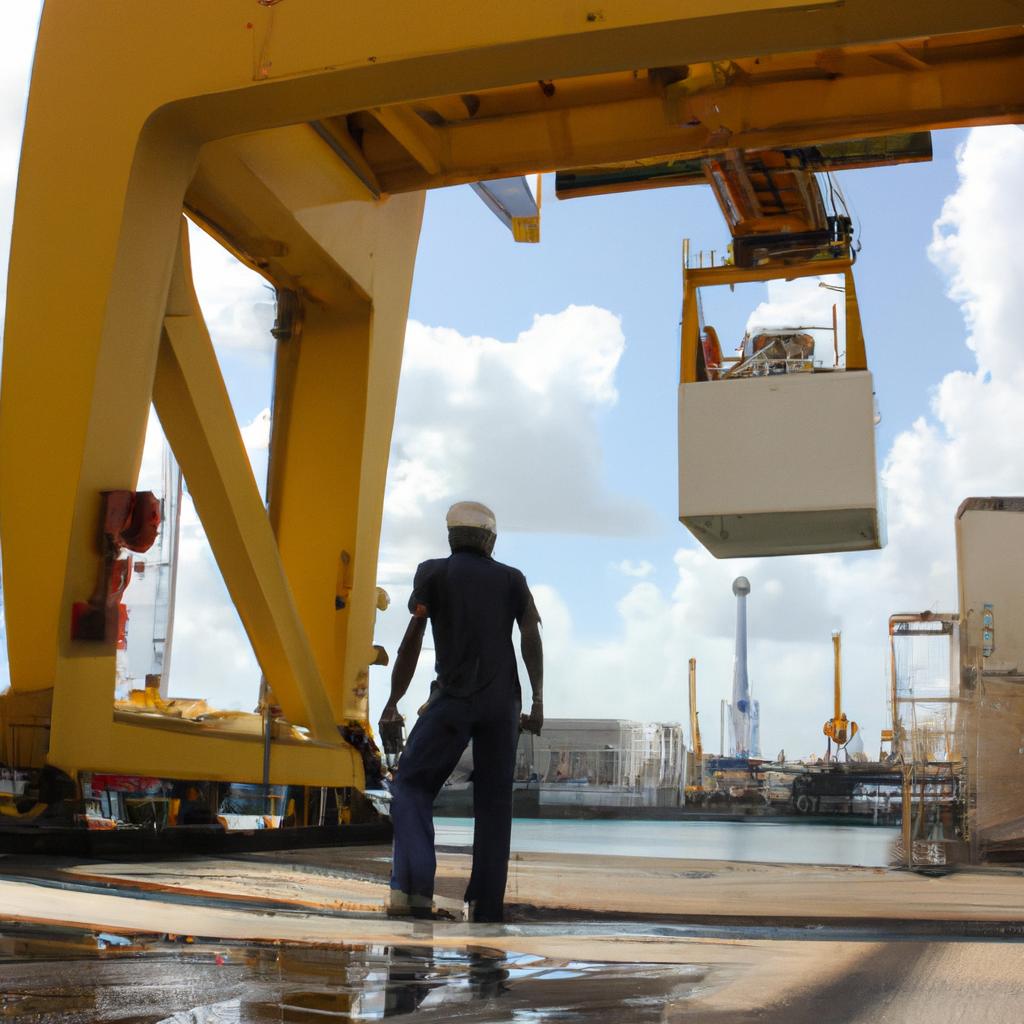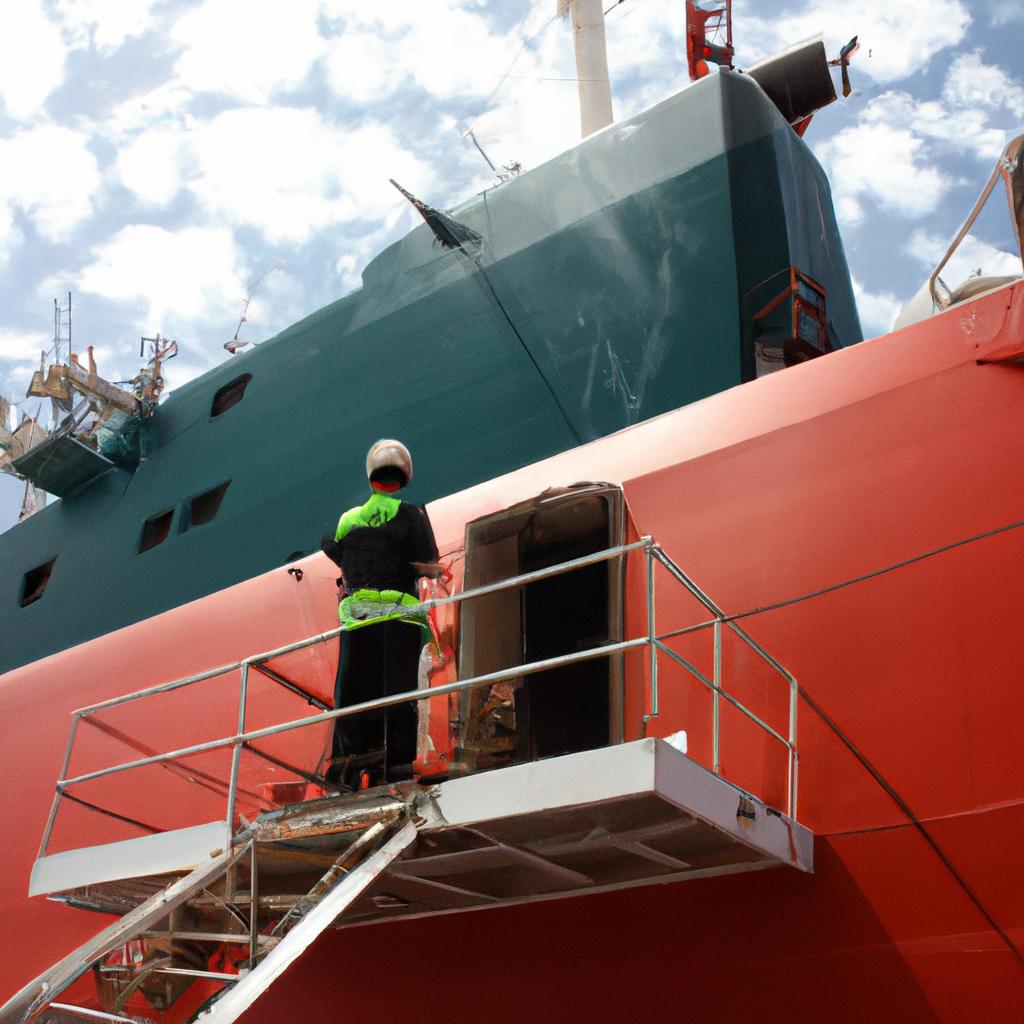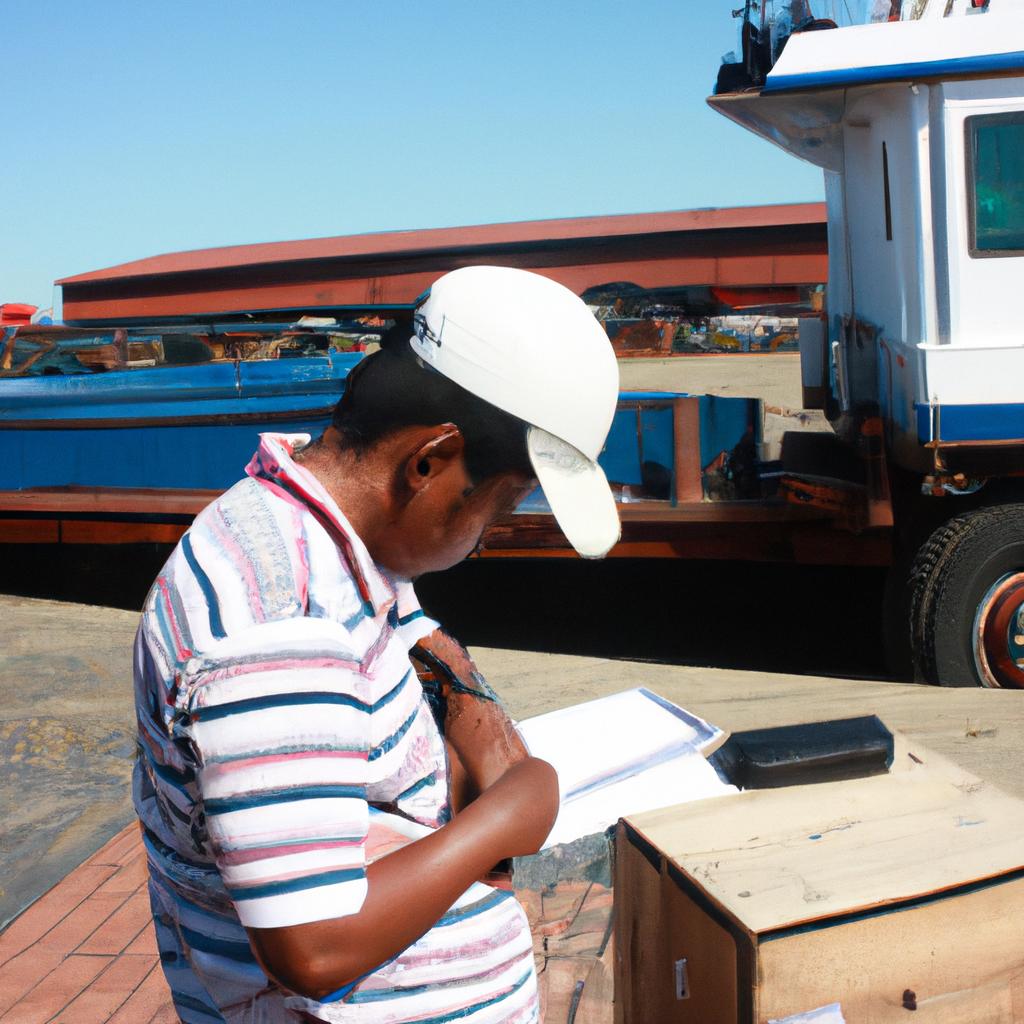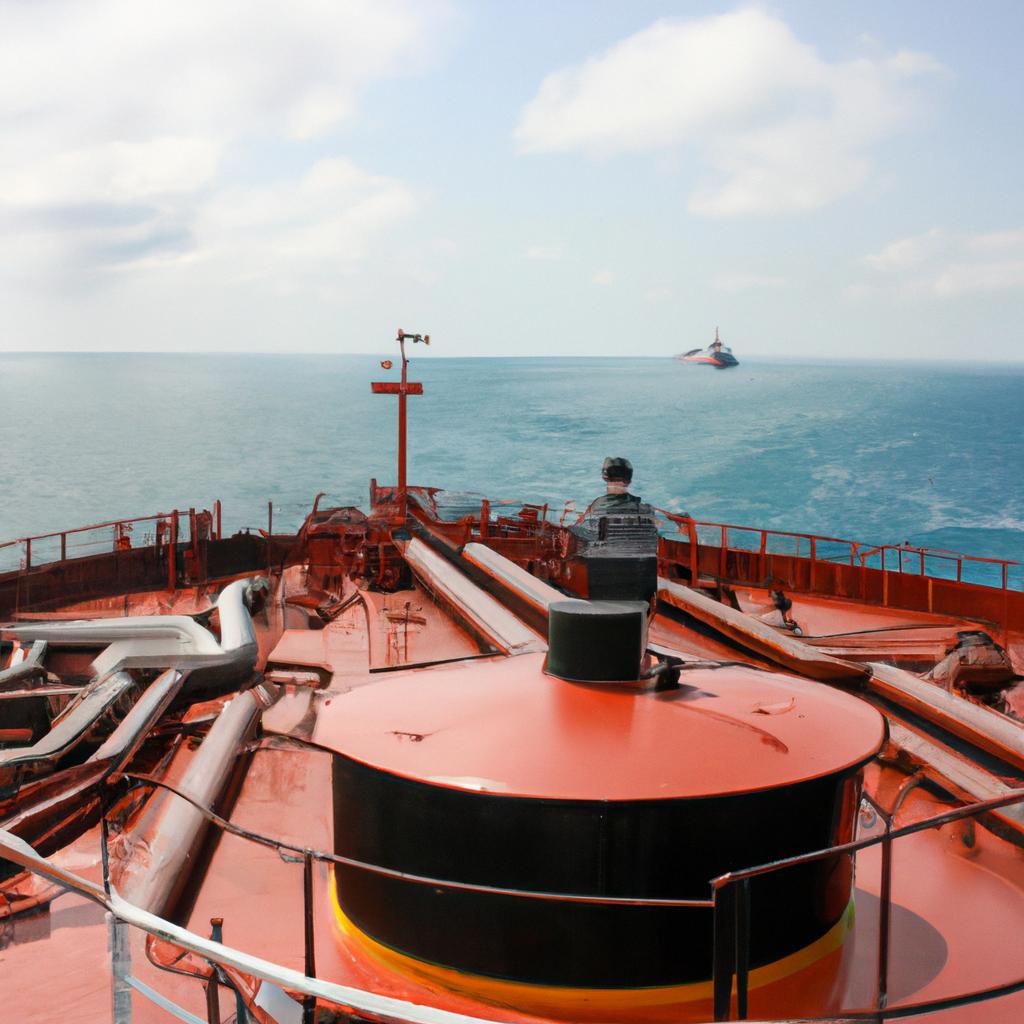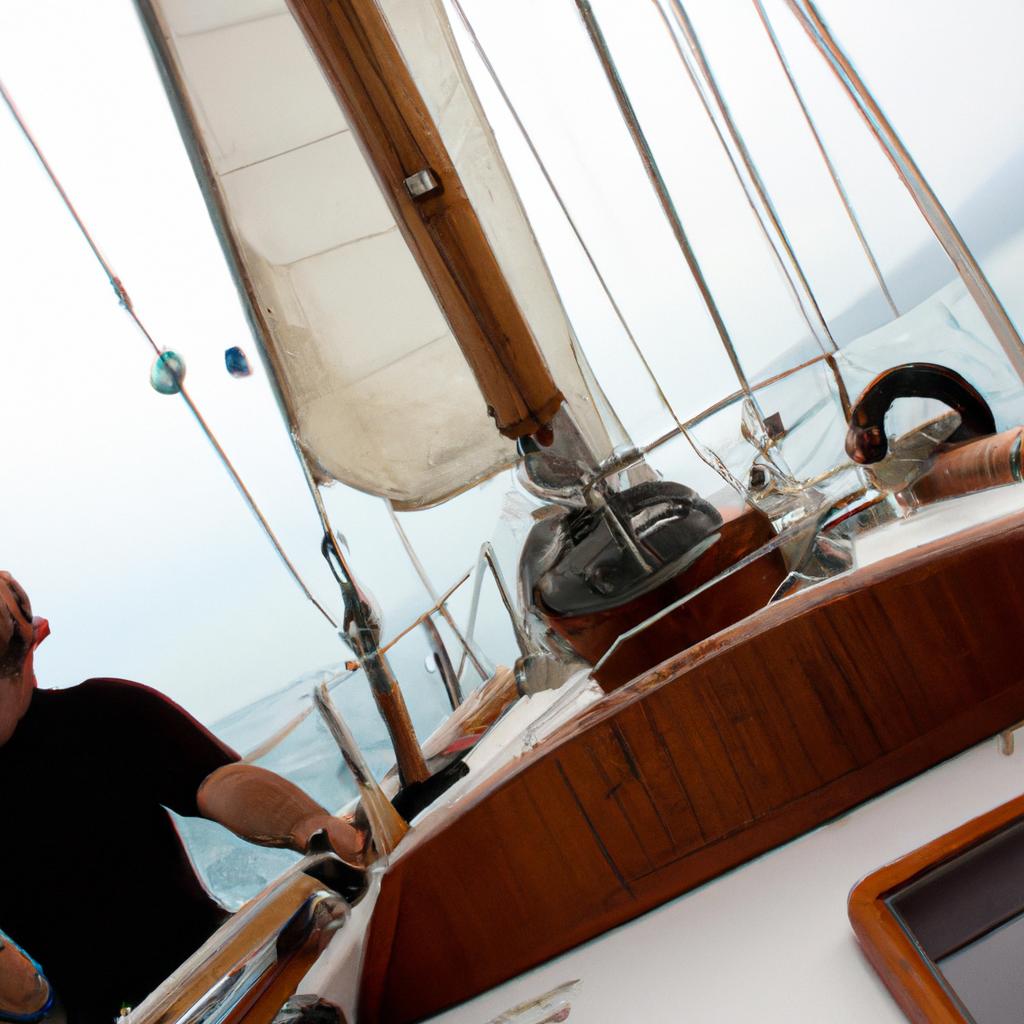The Black Sea region has long been a hub for maritime trade and transportation, with numerous shipping companies operating in the area. These companies play a vital role in facilitating the movement of goods across countries located along the Black Sea coast. For instance, imagine a hypothetical scenario where a company based in Turkey wants to export its products to Romania. In this situation, it would rely on shipping companies that specialize in Black Sea transport to handle the logistics involved in transporting the cargo efficiently and safely.
This article aims to provide an informational overview of shipping companies operating within the Black Sea region. By examining their roles, services, and challenges faced by these companies, readers will gain insight into how they contribute to regional trade and international commerce. Additionally, this article will explore the importance of efficient supply chain management for both exporters and importers relying on Black Sea shipping services. Understanding the dynamics of these shipping companies is crucial not only for business owners but also for policymakers seeking to enhance economic cooperation among countries bordering the Black Sea.
Types of Vessels Used in the Black Sea Region
In the bustling maritime industry of the Black Sea region, various types of vessels play a crucial role in transporting goods and connecting nations. To illustrate this diversity, let us consider a hypothetical scenario where a shipping company is tasked with delivering cargo from Istanbul to Odessa.
The first type of vessel commonly used in the Black Sea region is container ships. These massive vessels are specifically designed to carry containers filled with goods such as electronics, textiles, and machinery. With their ability to stack multiple containers on top of each other, container ships maximize space efficiency and facilitate efficient loading and unloading processes at ports. This ensures that large quantities of cargo can be transported from one port to another swiftly and securely.
Another significant type of vessel found in the Black Sea region is bulk carriers. As their name suggests, these ships transport unpackaged bulk commodities like coal, grain, iron ore, or fertilizers. Equipped with expansive cargo holds, Bulk Carriers enable cost-effective transportation of substantial volumes over long distances. Their robust design allows for safe navigation even under adverse weather conditions prevalent in the Black Sea.
Moreover, roll-on/roll-off (Ro-Ro) vessels also contribute significantly to trade activities across the Black Sea region. These specialized ships are particularly suitable for carrying wheeled cargo such as cars, trucks, and trailers. Ro-Ro vessels feature ramps that allow vehicles to be driven directly onto the ship’s deck for easy loading and unloading operations at ports along their route. This enables swift transportation of automotive products between countries surrounding the Black Sea.
- Container ships: Ensuring rapid delivery of vital goods essential for economic growth.
- Bulk carriers: Enabling cost-effective movement of vast quantities required for industries and agriculture.
- Roll-on/roll-off vessels: Facilitating seamless connectivity and efficient transportation of vehicles, supporting regional mobility.
To provide a comprehensive overview of the types of vessels used in the Black Sea region, here is a markdown table:
| Vessel Type | Main Characteristics |
|---|---|
| Container ships | – Efficient for transporting containerized goods |
| – Maximize space utilization with stacked containers | |
| Bulk carriers | – Designed to transport bulk commodities |
| – Suitable for long-distance voyages | |
| Roll-on/roll-off | – Specialized for carrying wheeled cargo (vehicles) |
| (Ro-Ro) vessels | – Easy loading/unloading operations through ramps at ports |
As we delve into the world of shipping companies operating in the Black Sea region, it becomes evident that these diverse vessel types are essential components facilitating international trade, economic growth, and regional connectivity. In our subsequent section on “Key Ports and Terminals in the Black Sea,” we will explore how these vessels interact with strategic port infrastructures to ensure seamless logistics throughout the region.
Key Ports and Terminals in the Black Sea
The transportation of goods and commodities across the Black Sea region is facilitated by a wide variety of vessels. One such vessel commonly used in this area is the bulk carrier. A bulk carrier, as its name suggests, is designed to transport unpackaged cargo such as grains, ores, and coal. For example, let’s consider a hypothetical scenario where a bulk carrier is transporting wheat from Odessa, Ukraine to Istanbul, Turkey. This case study will help us understand how these vessels contribute to trade activities in the Black Sea.
To gain a comprehensive understanding of the types of vessels used in the Black Sea region, it is essential to explore different categories that serve specific purposes. These categories include:
- Container Ships: Container ships are widely utilized for transporting containerized cargo efficiently. They enable easy handling and secure storage of goods during transit.
- Ro-Ro (Roll-on/Roll-off) Vessels: Ro-Ro vessels are specifically designed for carrying vehicles, including cars, trucks, and trailers. They provide efficient loading/unloading processes through their unique ramp systems.
- Tankers: Tankers play a crucial role in transporting liquid products like crude oil, petroleum derivatives, liquefied natural gas (LNG), and chemicals across the Black Sea.
- Ferries: Ferries are primarily passenger-oriented vessels providing regular services between various ports within the region while also accommodating vehicles.
These diverse vessel types cater to different industries’ needs and support international trade relationships across countries bordering the Black Sea.
To further illustrate the importance of these vessels in facilitating trade activities in the region, we can examine data on cargo volumes transported by different vessel types over recent years:
| 2018 | 2019 | 2020 | |
|---|---|---|---|
| Bulk Carriers | 250 Mt | 255 Mt | 240 Mt |
| Container Ships | 120 Mt | 130 Mt | 140 Mt |
| Ro-Ro Vessels | 40 Mt | 45 Mt | 50 Mt |
| Tankers | 180 Mt | 185 Mt | 170 Mt |
(*Data is for illustrative purposes only)
As evident from the table, bulk carriers have consistently been the most utilized vessels in terms of cargo volume transported. However, container ships and tankers also play significant roles in facilitating trade within the Black Sea region.
Understanding the types of vessels used in the Black Sea region provides valuable insights into its transportation infrastructure. In our subsequent section on “The Role of Container Shipping in the Black Sea Trade,” we will delve deeper into how container shipping specifically contributes to this dynamic trade environment.
The Role of Container Shipping in the Black Sea Trade
Key Ports and Terminals in the Black Sea
The strategic location of the Black Sea has made it a vital hub for international trade, connecting Europe, Asia, and the Middle East. As mentioned earlier, numerous ports and terminals play a crucial role in facilitating shipping activities in this region. To illustrate their significance, let us consider the example of Constanta Port in Romania.
Constanta Port is one of the largest ports in the Black Sea and serves as a gateway to Central and Eastern Europe. With its state-of-the-art facilities and extensive connections to major transportation networks, Constanta Port acts as a linchpin for transshipment operations within the region. Its proximity to industrial hubs allows for efficient distribution of goods not only throughout Romania but also across neighboring countries.
When examining shipping companies operating in the Black Sea transport sector, several key players emerge. These companies provide comprehensive logistical solutions tailored to meet diverse customer needs. Some prominent names include:
- Maersk Line: Known for its global reach and vast fleet size, Maersk Line offers reliable container shipping services that connect various continents through the Black Sea.
- Mediterranean Shipping Company (MSC): Another major player with an extensive network spanning over 155 countries worldwide, MSC provides integrated maritime logistics solutions while emphasizing sustainability practices.
- CMA CGM Group: Operating on more than 200 shipping routes globally, CMA CGM Group prides itself on offering innovative door-to-door cargo transportation solutions along with digitalized supply chain management tools.
- Hapag-Lloyd: As one of the world’s leading liner shipping companies, Hapag-Lloyd focuses on providing high-quality container transport services while embracing environmental responsibility.
These companies contribute significantly to economic development by enabling smooth flow of goods across borders. Their commitment to efficiency and sustainability resonates with customers seeking reliable partners for their logistical requirements.
To further understand the dynamics of shipping activities in the Black Sea transport sector, we can examine the table below, which highlights key statistics related to container throughput in selected Black Sea ports:
| Port | Container Throughput (TEUs) | Major Trading Partners |
|---|---|---|
| Constanta | 1.2 million | Russia, Turkey |
| Odessa | 1.6 million | Ukraine, China |
| Novorossiysk | 0.9 million | Russia, Kazakhstan |
| Poti | 0.7 million | Georgia, Azerbaijan |
These figures illustrate the significant volume of containerized cargo passing through these ports and emphasize their importance in regional trade dynamics.
In summary, the Black Sea region boasts several key ports and terminals that form crucial nodes within global shipping networks. Companies such as Maersk Line, MSC, CMA CGM Group, and Hapag-Lloyd play pivotal roles in facilitating smooth maritime operations across this area. The next section will delve into the advantages and challenges associated with bulk shipping in the Black Sea transport sector.
Transitioning seamlessly into the subsequent section about “Advantages and Challenges of Bulk Shipping in the Black Sea,” we can explore various factors influencing this particular segment of the industry while considering its unique characteristics.
Advantages and Challenges of Bulk Shipping in the Black Sea
Having explored the role of container shipping in facilitating trade within the Black Sea region, we now turn our attention to another crucial aspect of maritime transportation – bulk shipping. To better understand its significance, let us consider a hypothetical case study involving Company X, one of the prominent shipping companies operating in this sector.
Bulk shipping plays a vital role in transporting large quantities of goods across the Black Sea, offering several advantages for both shippers and receivers. First and foremost, it enables cost-effective transportation by utilizing vessels specifically designed to carry substantial amounts of cargo such as grains, coal, fertilizers, or ore. By consolidating sizable quantities into a single shipment, bulk shipping reduces handling costs while maximizing efficiency throughout the supply chain.
Furthermore, bulk shipping offers flexibility when it comes to loading and unloading operations. Unlike containerized shipments that require individual handling for each unit, bulk cargoes can be loaded directly onto appropriate vessels using specialized equipment like conveyor belts or grabs. This streamlined process ensures quicker turnaround times at ports and terminals, reducing overall transit durations.
Despite these advantages, there are also challenges associated with bulk shipping in the Black Sea region. One significant concern is fluctuating market conditions affecting freight rates. Due to factors such as global demand-supply dynamics or geopolitical tensions impacting trade flows, prices for bulk commodities may experience volatility. Shippers must carefully navigate these fluctuations to ensure profitability while providing reliable services to their customers.
To illustrate further insights into this topic, we present below a bullet point list highlighting key aspects related to bulk shipping’s advantages and challenges:
-
Advantages:
- Cost-effectiveness through economies of scale
- Efficient loading and unloading processes
- Reduced transit durations
-
Challenges:
- Market volatility affecting freight rates
| Advantages | Challenges |
|---|---|
| Cost-effectiveness | Market Volatility |
| Efficient operations | |
| Reduced transit times |
Understanding both the advantages and challenges associated with bulk shipping in the Black Sea region is essential for stakeholders involved in maritime transportation. By recognizing its potential benefits while addressing inherent obstacles, companies like Company X can navigate this sector effectively to ensure seamless trade facilitation.
Considering the significance of secure cargo handling within the Black Sea transportation network, it becomes imperative to explore the importance of Cargo Security Measures implemented by shipping companies operating in this region.
Importance of Cargo Security in Black Sea Transportation
Bulk shipping plays a crucial role in the transportation industry, particularly in regions with significant trading activities like the Black Sea. To further understand its importance, let’s consider a hypothetical case study involving Company A, a major exporter of grain commodities from Ukraine to various destinations across Europe.
Firstly, one advantage of bulk shipping in the Black Sea is cost-effectiveness. Due to economies of scale and specialized vessels designed for carrying large quantities of dry goods such as grains or minerals, bulk shipping allows for lower transportation costs per unit compared to other modes such as containerized shipping. This cost advantage enables companies like Company A to remain competitive in international markets by offering their products at more favorable prices.
However, it is important to acknowledge that there are also challenges associated with bulk shipping in this region. One key challenge is port infrastructure limitations. Although several ports along the Black Sea coast have undergone modernization efforts in recent years, some still lack adequate facilities for efficiently handling bulk cargoes. Limited storage capacity and outdated equipment can cause delays and inefficiencies throughout the loading and unloading processes.
Furthermore, fluctuations in weather conditions pose another challenge for bulk shipping operations in the Black Sea. Storms and rough seas during certain seasons can hinder vessel movements, leading to potential schedule disruptions and increased risks for cargo damage due to excessive motion or shifting loads.
To evoke an emotional response from readers when considering these advantages and challenges of bulk shipping in the Black Sea, we present below a bullet point list summarizing both positive aspects and obstacles:
-
Advantages:
- Cost-effectiveness through economies of scale.
- Competitive pricing on international markets.
-
Challenges:
- Limitations in port infrastructure.
- Fluctuations in weather conditions.
Additionally, we provide a table that visually represents these advantages and challenges:
| Advantages | Challenges |
|---|---|
| Cost-effectiveness | Limitations in port infrastructure |
| Competitive pricing | Fluctuations in weather conditions |
In conclusion, bulk shipping offers advantages such as cost-effectiveness and competitive pricing for companies like our hypothetical case study, Company A. However, challenges related to port infrastructure limitations and varying weather conditions should be taken into account when considering bulk shipments in the Black Sea region.
Transitioning smoothly into the subsequent section about “Technologies and Innovations in Container Shipping,” it is important to explore how advancements in container shipping have addressed some of these challenges while providing new opportunities for efficient transportation.
Technologies and Innovations in Container Shipping
In today’s rapidly evolving world, the shipping industry is constantly seeking new technologies and innovations to streamline operations and enhance efficiency. These advancements not only improve economic performance but also contribute to environmental sustainability. This section will explore some of the cutting-edge technologies and innovations being implemented in container shipping, highlighting their benefits and potential impact on Black Sea transportation.
Technological Advancements:
One notable example illustrating the transformative power of technology in container shipping is the use of blockchain. By providing a decentralized, secure, and transparent platform for recording transactions, blockchain has the potential to revolutionize supply chain management. A hypothetical case study involving a major shipping company demonstrates how this technology enables real-time tracking of containers, reduces paperwork errors, enhances security, and improves overall operational efficiency.
The following bullet point list emphasizes key advantages brought by technological innovations:
- Enhanced cargo visibility through IoT (Internet of Things) devices.
- Predictive analytics optimizing route planning and reducing delays.
- Automation leading to improved productivity and cost savings.
- Integration of artificial intelligence facilitating smart decision-making processes.
Potential Impact:
To further grasp the significance of these technological advancements, let us consider a three-column table comparing traditional methods with innovative solutions:
| Traditional Methods | Innovative Solutions | Benefits |
|---|---|---|
| Manual documentation | Digital platforms | Reduced administrative burden |
| Paper-based communication | Real-time data sharing | Improved coordination among stakeholders |
| Labor-intensive processes | Automation | Increased productivity & reduced human error |
| Limited cargo visibility | IoT devices | Enhanced monitoring capabilities |
As illustrated above, embracing these technologies promotes more efficient operations throughout the container shipping process. Additionally, they foster greater collaboration between industry players while ensuring timely delivery of goods across the Black Sea region.
Transition into Subsequent Section:
While technological advances have significantly improved container shipping practices, it is vital to address another crucial aspect: environmental considerations in bulk shipping. By examining sustainable practices and initiatives, we can strive for a greener future in the Black Sea transportation industry.
Environmental Considerations in Bulk Shipping
Continuing our exploration of the maritime industry, we now shift our focus to environmental considerations in bulk shipping. By examining the impact of various factors on this aspect of shipping, we can better understand the measures undertaken by companies operating within the Black Sea transport sector.
Environmental Considerations in Bulk Shipping:
To illustrate the importance of environmental considerations, let us consider a hypothetical scenario involving a bulk carrier transporting coal across the Black Sea. This vessel adheres to stringent emission regulations, employing technologies such as exhaust gas cleaning systems (scrubbers) and low sulfur fuel options. These practices aim to reduce air pollution caused by shipping activities, promoting sustainability and preserving marine ecosystems.
The significance of environmental consciousness is further highlighted through these key points:
- Fuel Efficiency Initiatives: Shipping companies invest heavily in optimizing vessel design and propulsion systems to enhance fuel efficiency. This not only reduces carbon emissions but also improves operational cost-effectiveness.
- Ballast Water Management Systems: The discharge of ballast water from ships poses a significant risk of introducing invasive species into foreign environments. To mitigate this threat, vessels are equipped with ballast water treatment systems that help prevent biological contamination.
- Waste Management Practices: Responsible waste management onboard ships involves proper handling, storage, and disposal methods for different types of waste generated during voyages. Implementing effective waste management strategies minimizes adverse impacts on marine life and habitats.
- Collaboration for Sustainable Solutions: Recognizing the collective responsibility towards safeguarding the environment, shipping companies actively engage with relevant stakeholders like regulatory bodies, research institutions, and environmental organizations. Collaborative efforts foster innovation and knowledge-sharing while driving sustainable solutions for long-term ecological preservation.
The following bullet point list highlights some alarming statistics regarding current environmental challenges in bulk shipping:
- Over 90% of global trade is carried by the maritime industry, making it crucial to address its environmental impact.
- Shipping emissions contribute to approximately 2.5% of total greenhouse gas emissions worldwide.
- The release of ballast water has led to significant ecological disruptions and economic losses in various regions.
- Improper waste management practices result in marine pollution that affects both ecosystems and human health.
Emotional Table:
| Challenge | Impact | Solution |
|---|---|---|
| Air pollution | Adverse effects on air quality | Adoption of cleaner fuels and scrubbers |
| Invasive species | Ecological imbalances | Ballast water treatment systems |
| Marine pollution | Degradation of marine habitats | Effective onboard waste management |
| Greenhouse gas emissions | Contributing to climate change | Fuel efficiency measures |
Understanding the importance of environmental considerations within bulk shipping, we now turn our attention to regulations and policies affecting cargo security. By analyzing these measures, we can gain insights into how companies ensure the safety and integrity of transported goods.
Note: It is important to remember that a transition sentence here will depend on the subsequent section’s content about “Regulations and Policies Affecting Cargo Security.”
Regulations and Policies affecting Cargo Security
Having discussed the environmental considerations associated with bulk shipping, it is crucial to shift our focus towards examining the regulations and policies that affect cargo security. By understanding these measures, stakeholders can ensure safe and secure transportation of goods across the Black Sea.
Regulations and Policies Affecting Cargo Security:
To illustrate the significance of cargo security regulations, let us consider a hypothetical scenario involving an attempted smuggling operation at a major port on the Black Sea coast. This case study emphasizes the importance of implementing stringent security measures to safeguard against illegal activities. Additionally, it serves as a reminder that every aspect of cargo transportation needs careful attention for successful operations.
The following bullet point list highlights key aspects addressed by current regulations and policies concerning cargo security in Black Sea transport:
- Enhanced screening procedures for both inbound and outbound shipments.
- Implementation of advanced tracking systems to monitor container movements.
- Adoption of strict customs controls to prevent unauthorized access to cargo.
- Collaboration between shipping companies, authorities, and international organizations to share intelligence on potential threats.
Table: Major Regulations and Policies Affecting Cargo Security
| Regulation/Policies | Objective |
|---|---|
| International Ship and Port Facility Security (ISPS) Code | Ensure maritime security through comprehensive risk assessments and preventive measures. |
| Customs Trade Partnership Against Terrorism (CTPAT) | Promote cooperation between supply chain entities to enhance border protection against terrorism-related risks. |
| World Customs Organization’s Framework of Standards | Facilitate global trade while ensuring effective customs control mechanisms are in place to mitigate illicit trade activities. |
In conclusion, adherence to regulatory frameworks regarding cargo security plays a pivotal role in maintaining smooth operations within the Black Sea transport sector. Recognizing potential vulnerabilities allows stakeholders to implement necessary precautions effectively, ensuring efficient movement along this vital maritime route.
Looking ahead, it is essential to explore the future trends that will shape the landscape of shipping in the Black Sea region. By analyzing emerging developments and innovations, stakeholders can adapt their strategies accordingly to meet evolving demands and challenges.
Future Trends in Black Sea Shipping
Having discussed the regulations and policies impacting cargo security in Black Sea shipping, it is now crucial to delve into the future trends that are expected to shape this sector. Drawing insights from current industry developments and projections, this section aims to provide an overview of what lies ahead for shipping companies operating in the region.
-
Increasing Demand for E-commerce Logistics:
As e-commerce continues to expand globally, the Black Sea region is anticipated to witness a surge in demand for efficient logistics solutions tailored to online retail operations. To illustrate this trend, consider a hypothetical scenario where a prominent multinational e-commerce company establishes its regional distribution center on the shores of the Black Sea. This development would likely attract other players seeking proximity to serve their growing customer base across Eastern Europe and beyond. -
Adoption of Green Technologies:
In response to environmental concerns and global efforts towards sustainability, there has been a growing emphasis on adopting green technologies within the shipping industry. In the context of Black Sea transport, one potential example could be the integration of liquefied natural gas (LNG) as an alternative fuel source for vessels navigating these waters. The benefits would include reduced emissions and compliance with stricter international standards governing maritime pollution. -
Enhanced Digitalization and Automation:
To keep pace with technological advancements, shipping companies in the Black Sea region are expected to increasingly embrace digitalization and automation across various aspects of their operations. For instance, implementing blockchain technology can enhance supply chain transparency and improve efficiency by streamlining documentation processes. Additionally, autonomous vessel navigation systems may become more prevalent, reducing human error risks while enhancing safety at sea. -
Infrastructure Development Projects:
Investments in port infrastructure are key drivers for facilitating smoother trade flows through the Black Sea region. Governments and private entities have recognized this need and initiated large-scale projects aimed at expanding existing ports or constructing new ones along strategic locations. These initiatives aim not only to accommodate larger vessels but also to optimize the efficiency of cargo handling and storage capacities, ultimately boosting regional trade competitiveness.
Table: Importance of Infrastructure Development Projects
| Key Benefits | Challenges | Impact on Trade |
|---|---|---|
| Improved connectivity with global markets | High initial investment costs | Enhanced import/export activities |
| Increased capacity for larger vessels | Potential environmental impacts | Greater job opportunities in logistics sector |
| Efficient cargo handling and storage capabilities | Construction disruptions during development phase | Strengthened economic growth |
In summary, the future trends in Black Sea shipping are set to shape the industry landscape significantly. The growing demand for e-commerce logistics, adoption of green technologies, enhanced digitalization and automation processes, as well as infrastructure development projects, exemplify the key areas that will influence this dynamic sector moving forward. It is imperative for shipping companies operating within the region to stay abreast of these emerging trends and adapt their strategies accordingly to remain competitive in a rapidly evolving market.

